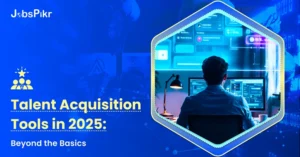Imagine a scenario. Applicant A has stumbled upon an open position at your company. They have a total of 8 years’ experience in Oracle products. Applicant B has 8 years of experience in the Oracle database. Applicant C has 8 years of experience in the Oracle commerce platform. Nearly indistinguishable? These are the nuances that any premium candidate matching software crawls, analyses, and hits it right off the park.
Two different sides emerge when the subject of job automation arises. One side thinks that these technologies need to be developed cautiously.
Or they believe that recruiting requires human efforts and not technological support. The other doesn’t give any credence to this perspective and believes that we have nothing to fear from the latest technologies, which allow us to delegate the most rote tasks to machines. And the latter point of view seems to touch every sector of business. Especially HR tech through job matching software.
Of all the problems a recruitment agency faces, job matching is the most convoluted.
According to Tilkee, latest edition of its barometer of recruiter’s habits, a recruiter currently spends an average of 34 seconds reading a CV — 21% less time than they did in 2017— which leads us to wonder just what an algorithm can do in 34 seconds.
It can choose between applicants A, B, and C in those 34 seconds. Without predilections.
In the modern recruitment landscape, candidate matching plays a crucial role in ensuring that the most suitable candidates are identified and aligned with job requirements. Understanding the nuances can significantly enhance the efficiency of your hiring process.
What Really is Candidate Matching?
Candidate matching is a critical aspect of the recruitment process. Effective candidate matching ensures that the best candidates are paired with the right job opportunities, maximizing both employer and employee satisfaction.
Merriam-Webster defines an algorithm as a procedure for solving a mathematical problem in a finite number of steps that frequently involves repetition of an operation. Here, we’ll be talking about the predictive analytics used in job recruiting, where algorithms are used to predict the future performance of employees in their new companies. Sourcing and filtering algorithms were created to help recruiting services do their job, but matching-algorithm platforms function as a search engine for people looking for jobs. Applicants post their résumé, which is then parsed using predictive analysis to find the jobs that best correspond to the skills cited on their CVs.
In simpler words, you get the best fit for your job. In seconds.
It makes it easier for candidates – they don’t have to fill out those deterring forms anymore. It makes it easier for companies – you just passed the baton to the lesser being.
The Importance of Candidate Matching
Candidate matching is not just a step in the recruitment process; it is the cornerstone of successful hiring strategies. Here are several reasons which is vital for any organization:
Enhances Job Performance:
Effective candidate matching ensures that the skills, experience, and personality of the candidate align with the job requirements and the company culture. This alignment leads to better job performance as candidates are more likely to excel in roles that fit their strengths and career aspirations.
Reduces Turnover Rates:
Poor candidate matching can result in high turnover rates, which are costly and disruptive to any organization. When candidates are well-matched to their roles, they are more likely to remain with the company for longer periods, reducing the need for frequent rehiring and retraining.
Improves Employee Satisfaction:
When employees feel that their job roles are a good fit for their skills and interests, their job satisfaction increases. This, in turn, leads to higher morale, better workplace relationships, and a more positive company culture. Effective candidate matching is key to achieving this harmony.
Saves Time and Resources:
The recruitment process can be time-consuming and resource-intensive. By focusing on candidate matching, recruiters can streamline the hiring process, quickly identifying the most suitable candidates and reducing the time spent on interviews and assessments.
Boosts Productivity:
Employees who are well-matched to their roles are generally more productive. They require less supervision and training, can hit the ground running, and contribute more effectively to the organization’s goals. This boost in productivity can significantly impact the company’s bottom line.
Supports Business Growth:
As businesses grow, having the right people in the right roles becomes increasingly important. Effective candidate matching ensures that the organization has a strong foundation of skilled and motivated employees who can drive business growth and innovation.
Promotes Diversity and Inclusion:
Candidate matching also plays a crucial role in promoting diversity and inclusion within the workplace. By using unbiased matching criteria, organizations can ensure they are considering a wide range of candidates from diverse backgrounds, contributing to a richer and more inclusive work environment.
Enhances Employer Brand:
Companies that are known for their effective candidate matching and positive hiring experiences often enjoy a stronger employer brand. This reputation helps attract top talent and can differentiate the organization in a competitive job market.
Keywords: The Chink in Our Armour
Suppose you’re a medical assistant working in a paediatrics office, and you’re looking for a new opportunity. With the typical job board software, “job matching” might mean that you type the words “medical” and “assistant” into a job search engine. There’s nothing wrong with this, except that it will present results for “assistant” positions that may have nothing to do with medicine, as well as results for “medical” positions that may have nothing to do with being a medical assistant.
In other words, you’ll waste time sifting through non-relevant job listings. Haven’t we come further than this by now? Many job board software products claim to have “job matching” included in their platforms, but they rely on keyword-based searching to run the platforms rather than the performance-based matching of positions to applicants. True job matching doesn’t rely on keyword searching, because it is about matching the most qualified candidates to the best jobs automatically and in real-time.
With true job matching, you would automatically match with medical assistant job listings for which you meet qualifications based on your resume, skill set and preferences. The Job matching would be effective by having quality data through job data scraping.
What does Candidate Matching Involve?
True job matching also automatically allows employers to receive qualified candidates right to their employer accounts, so that they can quickly review these candidates and make faster decisions.
As a job seeker for a medical assistant position. You would deliver job matches ranked by match percentage, helping you find the most relevant positions for which you’re qualified right away. Likewise, employers receive matches from active applicants and matching passive candidates directly into their employer account, graded and ranked based on match percentage. There’s simply no better or faster way for employers and job candidates to find each other.
Objectivity and Job Matching Software
One of the most underrated aspects of candidate matching in job boards is eliminating all human biases.
Humans are always conditioned to predispositions. We impulsively tend to believe that men are better at programming and women are better at HR. Candidate matching tools and software absolutely obliterate this.
Through objectivity, comes fairness and through fairness, comes equal opportunity.
Most of the job matching engines today only take into consideration the information directly extracted from the resumes and vacancies. The two sets of information match against each other based on some predefined rules.
We’ve come a lot further than that. Premium job matching tools and their sophisticated algorithm can almost take over a human.
We say almost. That is the operative word. And that shall always be.
Despite its benefits, candidate matching can be challenging due to the complexity of human behavior and job requirements. Overcoming these challenges requires a deep understanding of both candidates and job roles to achieve successful results.
The future of this process looks promising with advancements in AI and machine learning. These technologies will continue to refine the processes, making them more accurate and efficient.
Conclusion
In conclusion, candidate matching is a fundamental aspect of the recruitment process that significantly impacts an organization’s success. By aligning the strategic goals of the organization with the skills and aspirations of employees, an effective process enhances job performance, reduces turnover, and improves employee satisfaction. It streamlines the recruitment process, saving time and resources, while also promoting diversity and inclusion through a fair and unbiased selection process.
Ultimately, prioritizing candidate matching helps organizations build strong, capable teams that drive business growth and innovation. A well-executed strategy not only enhances the employer brand but also serves as an investment in the long-term success of the company, ensuring a competitive edge in the evolving job market.
If you liked reading this as much as we enjoyed writing this, please share the love. We think you might enjoy reading this just as much.




